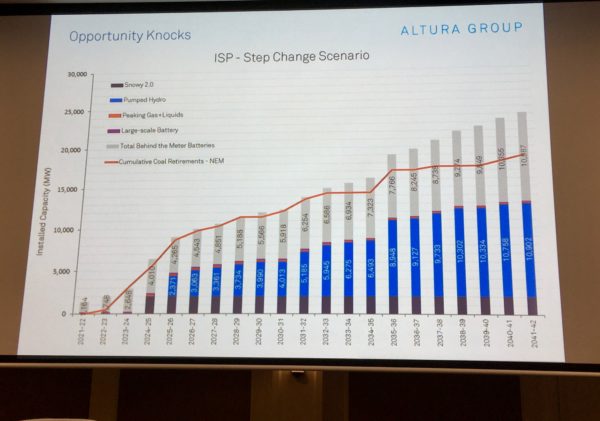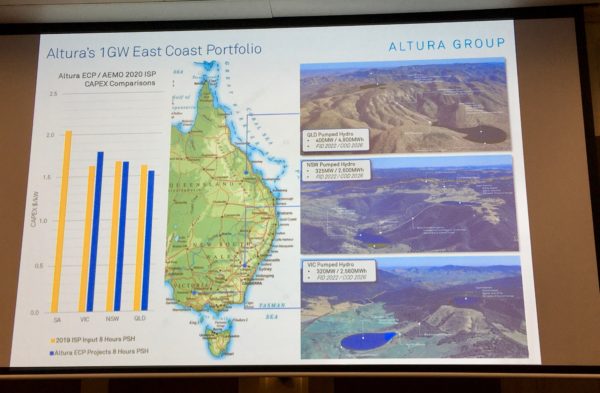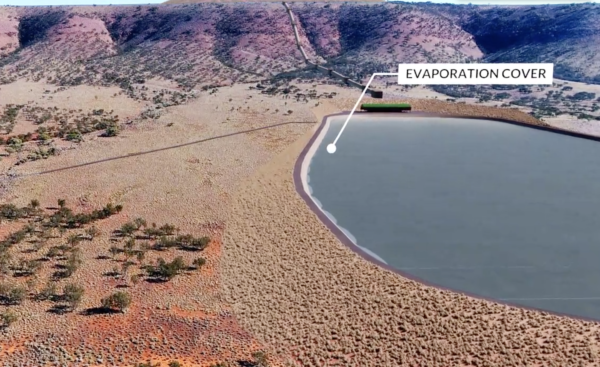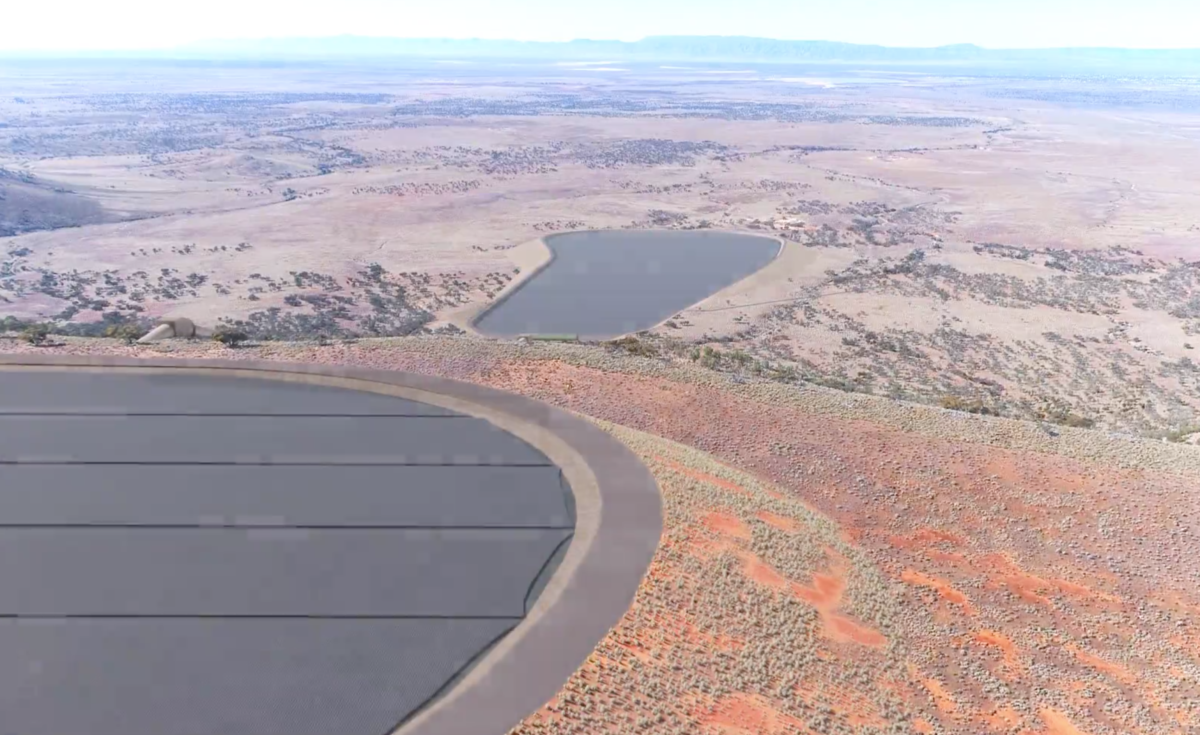At the Pumped Hydro and Battery Storage Conference last week, Altura Group, developers of the now shovel-ready Goat Hill pumped-hydro energy storage (PHES) project in South Australia, announced a trio of projects for the east coast of Australia, totalling more than 1 GW in PHES capacity that would be ready for deployment by the mid 2020s.
The renewable industry at the combined Informa Energy and Investment Series of conferences, which also included the Large Scale Solar Conference, was emphatic in its agreement that a roll out of dispatchable energy-storage projects — both battery and pumped hydro — is essential to enable penetration of the committed and proposed pipeline of large-scale renewable energy projects into the grid, to effectively replace retiring coal-fired plants throughout the National Electricity Market (NEM).
Altura Group Director, Christian Reilly, identified his proposed portfolio with the Step Change Scenario of energy transition outlined in the Australian Energy Market Operator’s (AEMO) Integrated System Plan (ISP), saying the opportunity identified in this accelerated ISP scenario is — in addition to Snowy 2.0 — for “a couple of gigawatts of pumped hydro,” by 2025.

Graph: AEMO
More renewables than the grid can cope with
Conference participants were largely agreed that the development of renewable-energy capacity is ahead of the ISP’s business-as-usual Central Scenario, and Mark Williamson, Executive General Manager of the Clean Energy Regulator, which administers Australia’s wildly successful Renewable Energy Target, said at the conference that new delivered renewable capacity, which he predicted would again hit 6 GW across Australia in 2020, “looks like it’s way ahead of the Step Change Scenario in the ISP”.
Said Reilly, who attended the conference with co-director of Altura Group, Rosahlena Robinson, “We think our model for pumped hydro can contribute to these projects coming to market within the next few years, which provides the impetus for this sector to displace coal and support significant volumes of variable renewable generation.”
Altura Group’s model, based on the Goat Hill project, near Port Augusta in South Australia, is for closed-loop, off-river pumped hydro systems, providing up to 400 MW over 8 hours, or 4,800 MWh of storage, and situated as close to load as possible, but always on strong or soon-to-be-upgraded transmission lines.

Image: Altura Group
The Queensland project, is on the coastal side of the Great Dividing Range roughly midway between Rockhampton and Mackay, and close to 275 kW transmission infrastructure. It’s also in close proximity to the proposed Clarke Creek Wind Farm, which is approved for up to 800 MW capacity, and the 315 MW Clarke Creek Solar farm; and “reasonably proximate” says Reilly, to CS Energy’s Callide Power Station complex, of which the 700 MW Callide B generator is the first of Queensland’s coal-fired power stations scheduled to retire, in around 2028.
In New South Wales, Altura’s proposed 325 MW /2,600 MWh pumped hydro project is in the location of Energy Australia’s closed Wallerawang coal-fired plant which ran two 500 MW turbines; it is on the edge of the 330-500 kW transmission ring serving the greater Sydney region; and within the prioritised Central West Renewable Energy Zone.
The reservoirs of the third plant, proposed for Western Victoria could bubble over with renewable assets seeking stabilising storage. Reilly said coolly that the region’s “significant wind and solar resources will benefit from the dispatchable capacity of our pumped hydro project”, which has a planned capacity of 320 MW/2,560 MWh
Based on Altura’s experience on pumped hydro projects in South America and lessons learned from Goat Hill, Reilly anticipates having all three new projects shovel ready within “the next couple of years”.
Efficiencies of the portfolio approach
He says the company’s portfolio approach was born out of the understanding that single projects are harder to drive to the point of viability; but that transfer of a proven technological approach and model into a fleet of projects for more-or-less simultaneous development makes better use of resources and can achieve faster delivery across the portfolio.
“We also wanted to provide some flexibility,” says Reilly. If CleanCo in Queensland, for example, wanted to incorporate new pumped hydro in the system by 2025, Altura’s model could adapt to prioritise that project.
“Obviously, there’ll be state-based signals, market and otherwise, which mean one project may gain preference over another.”
Reilly says Altura’s independent cost estimates for development of the three sites are in line with ISP calculations and, “should land at about $1.7 million a megawatt for eight hours of storage”.
He acknowledged “quite a long list” of challenges to getting pumped-hydro projects to commercial fruition, including the competition posed by ever cheaper battery storage, but said Altura had deliberately targeted the eight-hour capacity as a sweet spot for PHES.
Goat Hill persistence
The 242 MW/1,835 MWh Goat Hill project to be developed in association with Delta Electricity is currently awaiting investor approval. It is shortlisted for up to $40 million of ARENA funding, and is also on the shortlist for the Federal Government’s Underwriting New Generation Investment Scheme.
When Goat Hill received development approval in May 2018, Delta’s Chief Executive, Greg Everett, said, “With the growth of renewables and a reliance on high-cost gas generation, South Australians will benefit from the complementary, reliable and affordable energy storage that pumped hydro will provide.”
He described it as a world-class energy solution that would pump and store energy when renewable generation is abundant, and provide on-demand, dispatchable energy in the order of 230 MW of electricity for up to eight hours when required.
“The South Australia pumped hydro project will hit the market, having proven, albeit subsidised by a small amount, that these projects on the east coast can stand on their own two feet,” says Reilly. “That’s the ideal situation,” he says, whether they take advantage of energy capacity, ancillary services or other potential emerging market mechanisms.
Pumped hydro for regions of water scarcity?
When asked by Andrew Fletcher from Queensland Treasury Corporation, where the water for the Queensland project would come from in what is “a very arid region of Queensland”, Reilly replied:
“The Broadsound project has a catchment, so we have a reasonably predictable hydrology which allows us to gather the four gigalitres of water … We’re using turkey-nest construction — reservoirs lined with an impervious geomembrane which prevents seepage — and evaporation covers, which means the system is substantially in balance through the 50-70 years of operation.”

Image: Altura Group
Reilly says he and Robinson identify themselves as “first movers and risk takers”, and have over recent months discussed the transition outlook with numerous energy leaders. Reflected in those conversations, he says, was “a growing sense of conviction that our time to act is now”.
And not only is it imperative to act, but he says, “It’s an opportunity within the term of our careers to build an energy system and an economy which is clean, reliable and secure … assisting to stabilise climate and preserve resources for future generations.”
This content is protected by copyright and may not be reused. If you want to cooperate with us and would like to reuse some of our content, please contact: editors@pv-magazine.com.









1 comment
By submitting this form you agree to pv magazine using your data for the purposes of publishing your comment.
Your personal data will only be disclosed or otherwise transmitted to third parties for the purposes of spam filtering or if this is necessary for technical maintenance of the website. Any other transfer to third parties will not take place unless this is justified on the basis of applicable data protection regulations or if pv magazine is legally obliged to do so.
You may revoke this consent at any time with effect for the future, in which case your personal data will be deleted immediately. Otherwise, your data will be deleted if pv magazine has processed your request or the purpose of data storage is fulfilled.
Further information on data privacy can be found in our Data Protection Policy.